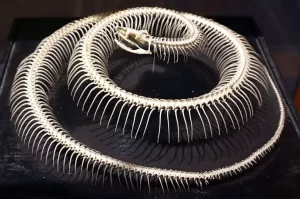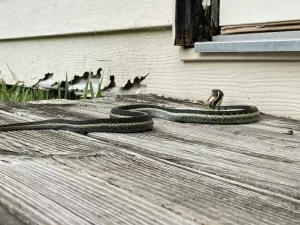Snakes have amazed humans for generations. One thing that often surprises people is how easily they can slide through small cracks, under doors, or into tight corners, even when they seem too big to fit.
Snakes are incredibly good at getting through tight gaps spaces. A good rule of thumb is: If a hole is wide enough for the thickest part of the snake to fit through, the snake can probably get through it.
This might not seem impressive until you realize that many smaller species of snakes, can squeeze through holes the size of a pencil!
Snake Bodies Are Built for Flexibility
Snakes are long, legless reptiles with bodies adapted to move in ways most other animals can’t. They have an incredibly flexible skeleton.
Most snakes have 100 to 400 tiny bones in the backbone (called vertebrae) and each of those vertebrae is connected to a pair of ribs. That’s hundreds of ribs!

Compared to humans, whose ribs form a rigid cage, a snake’s ribs are not fused together. They can move and bend individually.
This means a snake can flatten, twist, and stretch its body to fit through tight spots.
Their muscles help control this movement and allow them to adjust their shape as they slide forward.
If the widest part of a snake’s body can fit through a hole, the rest usually follows with little effort.
How Snakes Move in Tight Spaces
When snakes are moving across open ground, they use a smooth, flowing motion called lateral undulation ; curving their bodies into an “S” shape to push off the ground and move forward.
But in small or narrow places (like between rocks or inside pipes), they use a method called concertina movement.
In this type of movement, the snake anchors part of its body, pushes the rest forward and then pulls the rest along. This is kind of like an accordion opening and closing.
They can also flatten parts of their body to squeeze through cracks that seem too narrow.
This movement is slow, but it works well in confined spaces like walls, floor gaps, and underground burrows.
Just How Small of a Space Can a Snake Squeeze Through?
Remember this rule: If a space is big enough for the thickest part of the snake to go through, the snake can likely squeeze through.
This means a small snake can slip into very tight spaces.
Most young snakes or thin-bodied species can fit through gaps as small as a quarter of an inch. That is, the width of a pencil!

Even longer, thin-bodied snakes can slide into small gaps as long as their midsection isn’t too thick.
When squeezing through small spaces, length doesn’t matter, its thickness does.
Real Life Examples
There are plenty of examples of snakes escaping through small openings or getting into homes through barely noticeable gaps:
There are plenty of examples of snakes escaping through small openings or getting into homes through barely noticeable gaps:
- Pet snakes (like ball pythons or corn snakes) have escaped enclosures through small holes or loose lids.
- Garter snakes and other small species have been known to slide under closed doors through spaces as small as half an inch.
- In the wild, snakes often enter bird nests, and tree hollows, or crawl between rocks in search of food or shelter.
- In urban areas, snakes may enter homes through roof vents, wall cracks, or even through plumbing and drainage pipes.
These cases show that snakes are very skilled at using tight spaces.
Why Do Snakes Enter Tight Spaces?
Snakes don’t just squeeze into tight spaces for fun, they do it for survival.
1. To Find Food
Snakes like to ambush tiny animals like mice, lizards, or birds that hide in narrow crevices.
Their flexibility helps them follow prey into burrows, under rocks, or inside logs (places where other predators can’t follow).
2. To Escape Predators
Being able to squeeze into a hole or crack when threatened by a predator can mean the difference between life and death.
Narrow spaces act as protection from birds, small mammals, and other predators (including humans).
3. To Lay Eggs or Shedd Their Skin
Certain snakes lay eggs in protected or enclosed areas to keep them safe.
The same type of spaces are also perfect for shedding skin, a process where snakes are vulnerable and prefer to hide.
What Affects a Snake’s Ability to Squeeze Through a Space?
Not all snakes can squeeze through any hole. Many factors can affect whether or not a snake can squeeze through a hole:
- Size and species: Thin, light-bodied snakes like garter snakes or rat snakes can fit through smaller holes than heavy-bodied snakes like pythons or vipers.
- Surface texture: Snakes need traction to move. Smooth surfaces like tile or metal may be easier to slide on than rough surfaces.
- Body positioning: Snakes can adjust the way they move and position their body. By flattening their body or using different movements, they can slowly work their way into narrow spots.
Myths About Snakes and Tight Spaces
Because snakes can squeeze into tight spaces, people assume things that just aren’t true. Let’s debunk a few of the biggest myths:
Myth 1: All Snakes Can Fit Anywhere
False. Not all snakes are equally flexible. Smaller, thinner species are better at squeezing through tight gaps. Larger, heavier snakes are limited by their size.
Myth 2: Snakes Dislocate Their Jaws in Order to Get Into Cracks
Also false. Snakes do have extremely stretchy jaws, but they don’t dislocate them.
This ability is useful for them when they need to eat large prey, but it’s not useful when getting into small spaces.
Myth 3: Snakes Are Always Looking for Cracks to Hide In
Not exactly. Snakes don’t necessarily look for tiny gaps all the time for nothing.
They only do so when they are looking for prey, hiding, giving birth to offspring, or shedding their skin.
Conclusion
Snakes are experts at squeezing through small spaces. If the opening is wide enough for the thickest part of their body, most snakes can slip right on through.
It’s a survival technique that serves them well in the wild, enabling them to escape danger, find food, and reproduce.
It is not something to be feared; instead, it is something to be admired.
If you ever see a snake slipping under a door or vanishing into a crack, take a moment to remember: this is just nature at work.
These animals are not out to harm you, they’re simply doing what they’re built to do.
Featured image credit: Gerry Salmon (CC BY-NC 4.0)
Hi, my name is Ezra Mushala, i have been interested animals all my life. I am the main author and editor here at snakeinformer.com.

